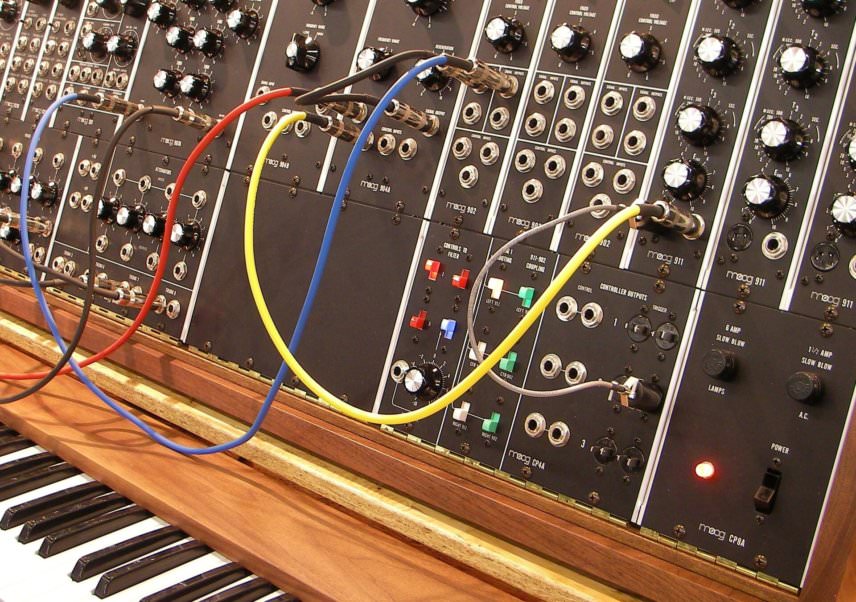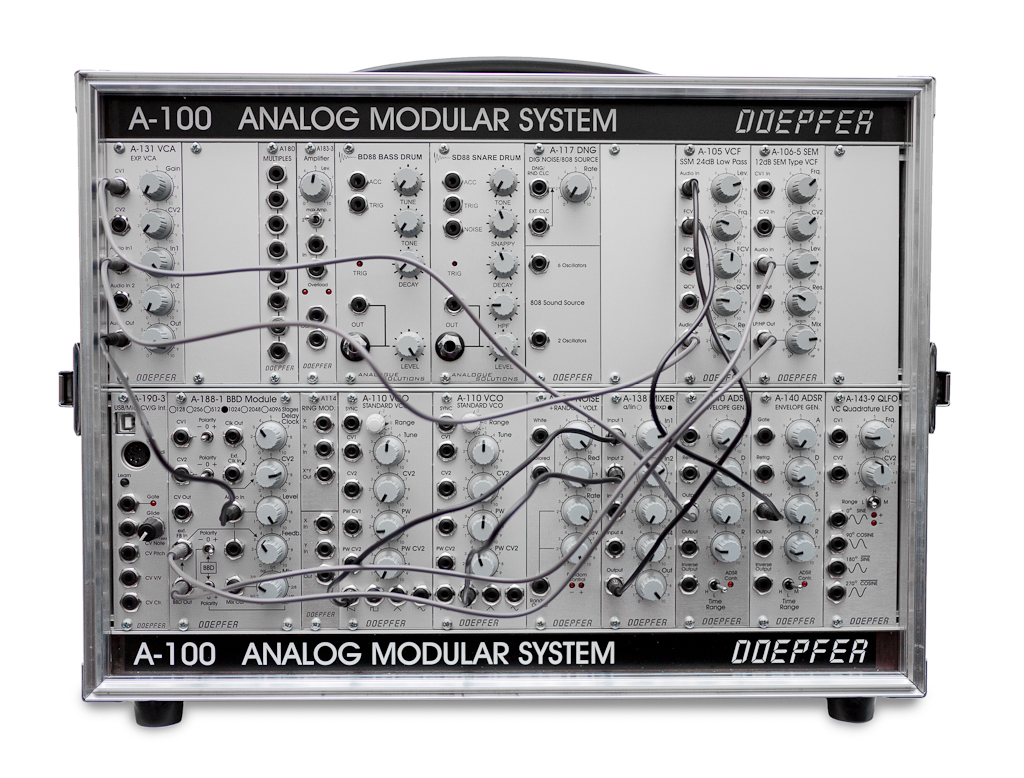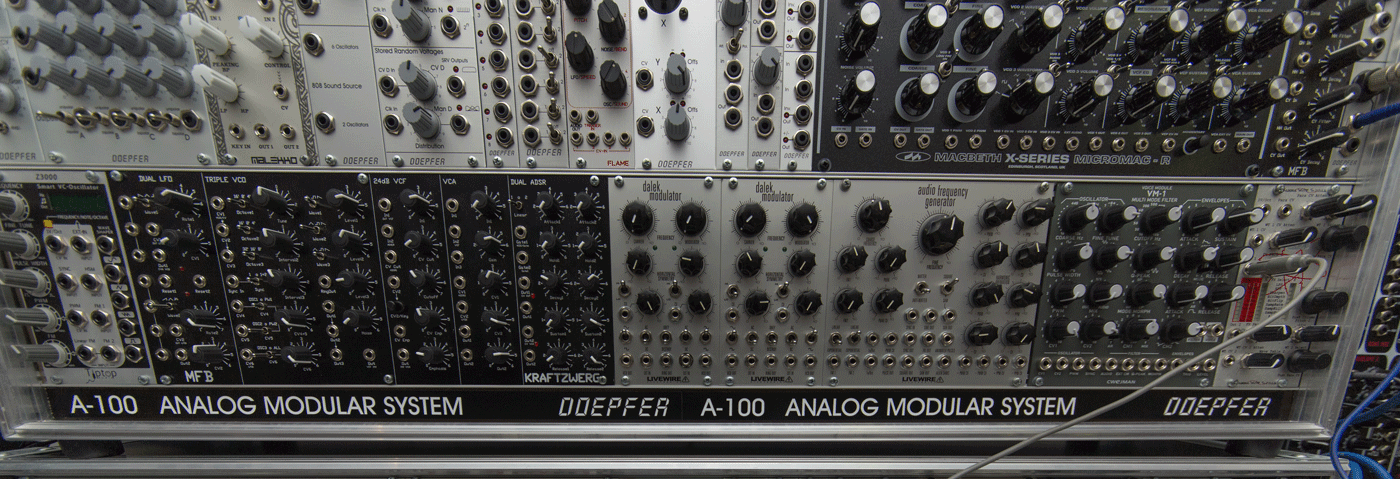In the last article, we covered what modular synthesizers are and how they work. In this article, let’s dig a little deeper into the different formats of modular synthesizers and explore the two most dominant options available today.
The Many Form-Factors of Modular Synthesizers:
Modular synthesizers come in several different form factors. “Form factor” describes the physical size of the front panels as well as other things like power specifications, the type of jacks used to connect modules together and the electrical standards that allow all the modules to “talk” to each other properly.
This kind of talk may sound highly technical and intimidating to novices, but there is really no need to worry. There are only a few things you need to know and it’s all very simple when it is broken down (which we will do in this article). Furthermore, once you have settled on a form factor, all you have to do is buy modules within that format and the modules will generally work very well together.
Moog and Eurorack. The dominant options.
Most modular synth enthusiasts will agree that there are two dominant modular synthesizer formats in use today: Eurorack (sometimes called “Doepfer” or “3U”) and Moog (also known as “dotcom” or “5U”). While there are other very nice alternatives such as FracRack, Serge, Buchla and others we will only focus on these two options for the sake of brevity.
The Moog (“5U”) form-factor:
The world’s first voltage controlled “modular synthesizer” was created by Bob Moog and his team at the R.A. Moog Company in the early 1960s. The company demonstrated its system at the AES convention in 1964 and began taking orders for systems in 1965. Units were initially purchased by a small number of forward-thinking composers with deep pockets and an interest in exploring new sounds (Eric Siday and Richard Teitelbaum, for example).
However, within a few years, Moog Modular synthesizers had found their way into recording studios and popular music as well. For example, in 1967 The Monkeys used a Moog Modular system in their fourth album (a Billboard #1 hit) Pisces, Aquarius, Capricorn & Jones Ltd. In 1968 Wendy Carlos used a Moog Modular on the seminal electronic album Switched-On Bach. This album was a major event in the history of electronic music as it was many peoples’ first exposure to music made by synthesizer. By the 1970s Moog Modular systems were used by many of the top musicians of the time including Keith Emerson, Jan Hammer, Klaus Schulze, Tangerine Dream, The Beatles and The Rolling Stones.

Moog’s company (called Moog Music after 1972) continued to manufacture modular synthesizers until 1980. While the original production stopped in 1980, a handful of boutique manufacturers have carried on creating new modules as well as clones of existing Moog designs. These boutique manufacturers include Synthesizers.com (popularly known as “dotcom” modules), MOTM and ModCan. These boutique modules feature the same physical size and 1/4” (6.35mm) jacks of the original Moog format, but include modernized technology and improved power distribution compared to the original Moog design (they can generally be adapted to work with original Moog modules if desired). Since 2014, Moog Music itself has been creating very limited reissues of their original modules at extremely “premium” (high) prices!
Moog and the other boutique “5U” systems are highly coveted among the synthesizer community. The larger size of the front panel allows units to have larger knobs and switches that are generously spaced apart and there is enough room for large, clear labelling. These systems use larger ¼” jacks and cables which make for a more satisfying patching experience. Finally, these imposing cabinets with uniformly colored modules can be very visually very impressive and their sound output is always glorious. There are few “cheap and cheerful” modules in the 5U format—everything tends to be expensive and great-sounding. The downside is that the systems tend to be quite heavy, module options are more limited due to the small number of manufacturers, and the systems are more difficult to transport. And lastly..the systems have a wallet busting price tag. Ouch!
Eurorack (“3U”) form-factor:
In 1995, Dr. Dieter Doepfer’s company Doepfer Musikelektronik GmbH created a modular synthesizer called the A-100. The system was a modular synthesizer like the Moog Modular, but there were two important differences:

Firstly, Doepfer modules had a “3U” height, a much narrower minimum width of only 10mm (compared to Moog’s 2.125” or 54mm), and smaller 1/8” (3.5mm) jacks to connect modules. This smaller size allowed Doepfer systems to pack far more functionality in the same sized case. They are easier to transport and with the smaller front panels and accompanying circuit boards they tend to be generally cheaper than their 5U counterparts.
Secondly—and perhaps more importantly—Doepfer published its system specifications in 1996 under the “Eurorack” name and encouraged third parties to build their own modules to work alongside the A-100 system modules. This approach worked extremely well and many small manufacturers began building specialized modules of their own. The number has grown year over year and by 2018 the ecosystem had expanded to over 300 brands with over 7000 (!) Eurorack modules. That is a staggering number of options!
Eurorack systems tend to be physically smaller, easier to transport, and less expensive than the 5U counterparts. There is an extraordinary diversity of modules in this ecosystem with varying degrees of quality ranging from “cheap-and-cheerful” (i.e., entry level) to “sublime” (professional and expensive). The dizzying array of options can make systems look and feel visually very cluttered and most would agree that the ergonomics are not as nice as the larger 5U alternatives. Furthermore, having so many choices leads some users to experience option anxiety when configuring systems or purchasing modules. Despite this, Eurorack is undoubtedly the most dynamic and exciting area in modular synthesis today and is beloved by many users around the world.
3U? 5U? Why do they call it “U” ?
The physical height of Moog, Eurorack and many other formats of modules is determined by the widely used “rack unit” mounting standard. This is the same standard that is used in recording studios around the world to mount equipment like preamplifiers and compressors. This standard was originally created by AT&T to house telephony equipment and continues to go strong after nearly 100 years. In fact, state of the art data centers still use the 19” rackmount standard to house servers, switches and other equipment. So do many research laboratories, radio stations and broadcast facilities.
Each rack unit is defined to be 1.75” tall. Moog decided to make their modules 5 rack-units tall, so the total height for each row of modules was 8.75”. This is where the shorthand “5U” comes from. Doepfer’s A-100 front panels were based on the 3U “Eurocard” standard commonly found in research laboratories for test equipment (Dieter Doepfer became familiar this standard during his PhD studies and later decided to use it on his A-100 system). In some forums you will hear users refer to a “6U or 9U” Eurorack case, this is shorthand for a case containing two or three rows of modules.
Conclusion:
If you want to get into modular synthesis, one of the biggest decisions you will need to make is the form-factor of your system. The two dominant options are the luxurious Moog/5U systems or the wildly-popular Eurorack standard.
Unless you have specific reasons for opting otherwise (for example you just love the look and sound of a Buchla modular), our recommendation is to go for Eurorack. It is comparatively cheaper, smaller, more portable and—by far—the most diverse ecosystem out of any modular synthesizers. There are new modules appearing each month, the system can produce phenomenal sounds and there is enough here to keep users busy for years.
